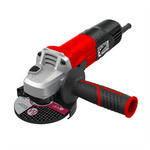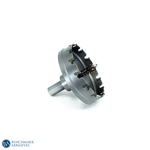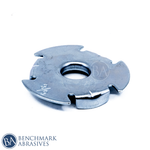
Typical Errors When Applying Abrasive Materials

Abrasives are essential tools mainly used for shaping, smoothing, and finishing materials in a range of industries and DIY projects. These are available in several ranges, starting from basic sandpaper to robust grinding wheels. Although several common errors regularly jeopardize the safe and productive use of these simple and basic tools. These errors can cause inefficient material removal, severe safety risks, early abrasive wear, and, eventually, poor finish quality.
For everyone dealing with abrasives, regardless of expertise level, it is essential to recognize and actively avoid these dangers in order to ensure safer operations, increase productivity, and achieve the necessary high-quality outcomes. In this blog, we’ll cover the 12 typical errors or common mistakes while applying abrasive materials.
12 Typical Errors When Applying Abrasive Materials
Here is the list of 12 typical errors while using abrasive materials, with their prevention:
1. Using an unsuitable abrasive for the task.
Selecting the incorrect abrasive for the material and for the project is a common error that can cause severe issues. Different materials need specific abrasives. Using the wrong or inaccurate abrasive can cause damage to the surface, or it will be ineffective. For instance, using coarse sandpaper on a softer wood or eliminating extremely heavy rust by using a very fine polishing compound.
Therefore, it's crucial to learn the characteristics of various abrasives as well as the specific requirements of the material you are working with. Ensure to research the right abrasive for the application, and when you're not sure, start with a less aggressive abrasive and gradually move to finer grits as required.
2. Using Worn-Out Abrasives
Continuously using dull, clogged, cracked, or chipped abrasives leads to several issues and unwanted results. The cutting effectiveness will be reduced, resulting in generating excessive heat due to friction and smearing debris across the surface rather than eliminating material. This further results in slowing down the process and requires more pressure, which can cause uneven results and damage the workpiece.
Ensure to frequently inspect your abrasives, and if they show any sign of wear, replace them immediately, which is vital for effective, secure, and top-notch work. A new abrasive will help you cut faster, cleaner, and require less pressure, which results in saving your time and resources in the long run.
3. Applying Excessive Pressure
The common yet harmful error is when you push harder when an abrasive appears slow. Applying excessive pressure will not speed up the material removal process; rather, it can cause a number of issues, including quick wear, clogging, and the generation of excessive heat. This will further cause damage to the workpiece, which includes burning and discoloration, especially with softer or delicate materials. Additionally, applying undue pressure can also cause loss of control, which leads to uneven material removal, gouges, and a rough finish.
Ensure to apply steady, moderate pressure and let the abrasive do its work. If material removal is slow, then use a coarser grit or check if the abrasive is clean and sharp for effective removal.
4. Ignoring Safety Precautions
Ignoring safety precautions is another common error that can lead to several issues. Material removal is the process wherein a large amount of dust or flying debris is generated, which can cause severe health issues related to respiratory issues, eye injuries, and skin abrasion. You put yourself at direct risk of these dangers if you don't wear appropriate safety gear like respirators, face shields, masks, gloves, helmets, and much more.
You must prioritise safety when working with abrasives by using personal protective equipment (PPE) consistently, maintaining enough ventilation, and following safe operating procedures. This will help you avoid avoidable injuries and safeguard your health.
5. Inappropriate Surface Preparation
Failing to prepare the surface inappropriately will lead to several issues, and it's one of the most common issues occurring while using abrasives. If the surface is not clean, it can contaminate the abrasive and generate uneven results. These contaminants are capable of clogging the abrasive, which in turn reduces its lifespan and efficiency. They can also grind into the surface, which leads to scratches or unwanted errors. Fixing significant flaws in advance with degreasing, cleaning, and some early leveling will produce a steadier starting point.
6. Operating at an Inaccurate speed
Operating at an incorrect or wrong speed is a critical mistake that a user can make while using abrasives with grinders. Operating a grinding wheel at too high a speed can cause overheating or breakage, which results in overheating and the risk of the shattering of wheels. Working at the correct speed that matches the abrasive and the material being worked on will lead to efficient material removal, producing a fine and smooth finish.
7. Incorrect wheel mounting
Incorrect wheel mounting is also a crucial common mistake to avoid that can cause severe issues, including rough surfaces, flying debris, and the risk of severe accidents. Not installing wheels correctly can also cause vibrations, which result in a lack of control over the grinder and cause accidents.
To avoid all these errors, ensure to use the right flanges, that they are clean and in excellent shape, and that the wheel is fastened with the right blotters—not too tight, not too loose. It is not just advised to carefully follow the manufacturer's wheel installation instructions; doing so is a basic safety need while using grinding equipment.
8. Neglecting the wheel Dressing
Neglecting wheel dressing is also a common mistake that occurs when using abrasives. Cutting wheels' friction particles eventually get dull or clogged with debris. This loaded surface loses its capability to cut effectively. To ensure that mounting hardware and flanges are regularly mounted. Use the appropriate blotters, which are compressible washers. Tighten the nuts evenly without overtightening. Follow the instructions provided by the manufacturer.
9. Overheating the Workpiece
A typical error that can have negative effects during abrasive procedures, especially grinding, is to let the workpiece overheat. Overheating can occur due to the friction between the material and the abrasive during operation. It can also happen due to using dull abrasives, a lack of proper coolant, or operating at an incorrect speed.
To avoid overheating, ensure to use the proper coolants or lubricants, use sharp abrasives, and operate at moderate speed, especially when dealing with harder materials.
10. Using Cutting Discs for Grinding
One of the most dangerous mistakes is using a cutting disc for grinding. These cutting discs are mainly designed to cut along their thin edges with minimal lateral force. Although they are usually strengthened, they are not intended to endure the strains caused by grinding, which is the process of exerting pressure on the disc's face or sides at an angle to remove material.
Trying to use a cutting disc for grinding puts it under extreme stress, causing disc fracturing or shattering at high speed, which can cause damage to the operator as well. So, ensure you have the correct type of abrasive disc.
11. Improper workspace organization
Improper workspace organization or a cluttered and disorganized workspace substantially increases the risk of severe accidents when using abrasives. Improper workspace refers to loose wires or items on the floor, causing tripping, putting tools here or there, and causing accidents. Dust accumulated can also cause health issues. To avoid this, ensure you maintain a clean and organized workspace for improved performance.
12. Lack of risk assessment
Dealing with abrasives without performing a thorough risk assessment is similar to moving forward without being aware of the possible risks. This includes noise, dust inhalation, flying debris, and chances for contact with moving parts. Without having an idea about specific tasks, materials, or tools, you cannot take appropriate preventative measures.
In a basic risk assessment, possible hazards are identified, the likelihood and seriousness of harm are assessed, and control measures are put in place to lessen the risks. An essential component of any abrasive activity, skipping this step greatly raises the risk of mishaps and injury.
By having an idea of these typical errors and by following the precautionary measures, you can effectively and efficiently use abrasives.



































































